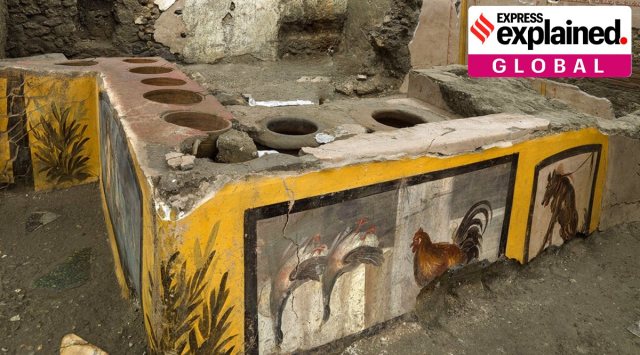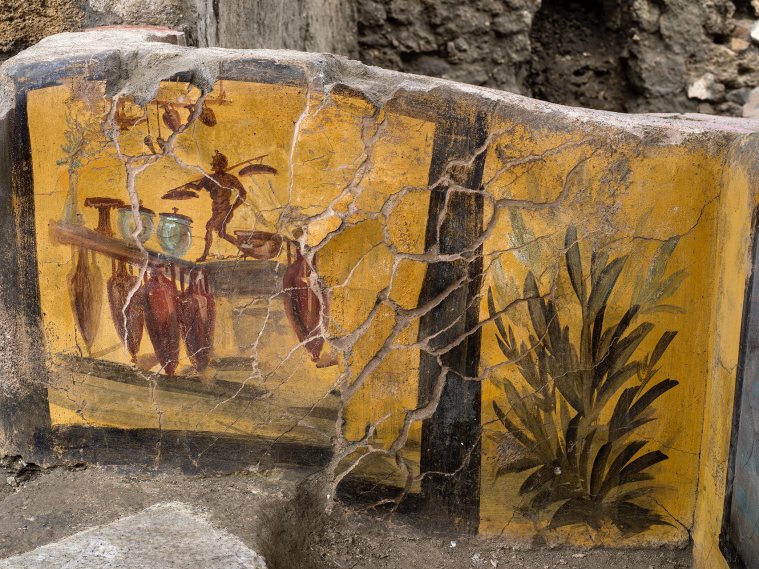- India
- International
Explained: The significance of a nearly 2,000-year old snack bar unearthed at Pompeii
Pompeii was a Roman town in Southern Italy’s Campania region situated along the Bay of Naples. The town was completely buried by volcanic ash after the eruption of Mount Vesuvius in 79 CE, over 2000 years ago.
 The snack bar appears decorated with "polychrome patterns and frozen by volcanic ash". (Source: Instagram/@massimo_osanna)
The snack bar appears decorated with "polychrome patterns and frozen by volcanic ash". (Source: Instagram/@massimo_osanna)Researchers have unearthed a thermopolium, Latin for hot drinks counter, in the Roman empire town of Pompeii, today one of the world’s largest and most significant archaeological sites.
The snack food counter called the thermopolium at the Pompeii archaeological park’s Regio V, which was partially excavated in 2019 was found complete with an image of a Nereid riding a sea-horse, decorative still-life frescoes, food residues, animals bones and victims who died during the volcanic eruption of 79 CE.
The find is significant because it shows the variety of food consumed by the residents of the town — traces of pork, fish, snails and beef have been found in the containers of the stall. It is also the first time an entire thermopolium has been excavated, complete with pateras, or bronze drinking bowls, ceramic jars used for cooking stews and soups, wine flasks and amphora, usually used for storing and transporting wine and olive oil.
What is the story of Pompeii?
Pompeii was a Roman town in Southern Italy’s Campania region situated along the Bay of Naples. The town was completely buried by volcanic ash after the eruption of Mount Vesuvius in 79 CE, over 2000 years ago. However, it was not only the residents of Pompeii who were affected (over 16,000 died), the eruption also destroyed the neighbouring town of Herculaneum. Even so, it is due to the tragedy that the town is well preserved and has given archaeologists vast materials to study daily Roman daily life, as it was centuries ago.

Located 8 km from the volcano, Pompeii was as a resort town frequented by Rome’s elite citizens and consisted of villas, cafes, marketplaces and a 20,000-seat arena.
 An undated photo made available by the Pompeii Archeological park press office shows the thermopolium in the Pompeii archeological park, near Naples, Italy. (AP)
An undated photo made available by the Pompeii Archeological park press office shows the thermopolium in the Pompeii archeological park, near Naples, Italy. (AP)
In “Pompeii and the Roman Villa: Art and Culture around the Bay of Naples”, an exhibit organised at the National Gallery of Art, Washington in 2009, 142 objects including sculptures, frescoes, mosaics, decorative objects, paintings, and rare books associated with Roman-era villas of Pompeii and nearby areas were displayed. The exhibit focussed on Pompeii as an artistic centre, a place where prominent Romans occupied seaside villas and spent their time reading, writing and exercising.
When did the excavations at Pompeii begin?
In 1748, King Charles III of Bourbon initiated scientific excavations at the site, after which large parts of the city have been unearthed, and several artifacts and other items of interest discovered: all well-preserved due to the layers of ash the town was submerged in. But even before the 18th century, the first excavations began in 1592.
 A fast-food eatery discovered at Pompeii is now completely excavated, helping to reveal some favorite dishes of citizens of the ancient Roman city who liked to eat out. (AP)
A fast-food eatery discovered at Pompeii is now completely excavated, helping to reveal some favorite dishes of citizens of the ancient Roman city who liked to eat out. (AP)
Last year, the Italian Culture Ministry announced the discovery of well-preserved remains of two men who perished during the volcanic eruption.
What have excavations revealed so far?
As per the Archaeological Park of Pompeii, research into Pompeii and Herculaneum so far has revised scientists’ understanding of the town, the disaster and the sequence of events. Further, the investigations of those who died have also revealed details of the town’s citizens and a revised interpretation of a rescue operation launched by the admiral of one of Rome’s navies, Pliny the Elder, stationed at the Roman Naval base of Misenum situated on the opposite side of the Bay of Naples at the time.
While he died during the mission, his nephew, Pliny the Younger, wrote a letter to historian Tacitus who later cited the letter in his work Historiae on the first centuries of the Roman empire. In his letter, the 17-year-old gave a first-hand account of the eruption.
More Explained
EXPRESS OPINION
Apr 25: Latest News
- 01
- 02
- 03
- 04
- 05










































